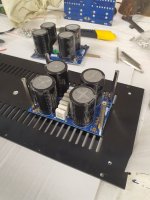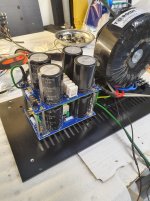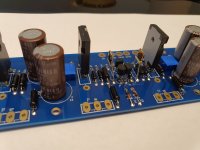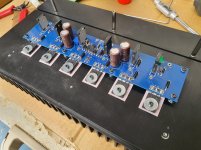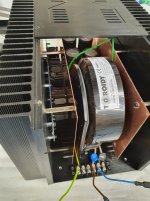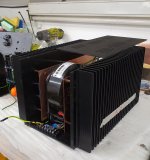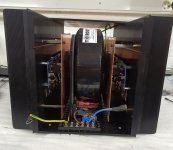I think this really calls for you to experiment. When you have two stereo F4's
both operations are available with some changes in input/output cabling
configuration.
And for both configurations you will need gain from a preamp to get to full power.
both operations are available with some changes in input/output cabling
configuration.
And for both configurations you will need gain from a preamp to get to full power.
I think this really calls for you to experiment. When you have two stereo F4's
both operations are available with some changes in input/output cabling
configuration.
And for both configurations you will need gain from a preamp to get to full power.
Thanks Dennis.
I mailed Mr Pass and he had a good point. With 4 ohm speakers bridged will play louder but parallel will give less distorsion.
I have no need to play really loud so I will go parallel as a start.
Thanks everyone for your feedback. For a 8 ohm speakers bridged would be a non brainer.
say what's line stage you're using with F4, then we have full info
XA25 is by itself damn good amp, but obviously too low in THD amount for your liking
rest of them I can't comment (in general - liking idea of any decent made toob amp, but being absolutely indifferent to any digital drek around) .......
I was running directly from my DAC (at the time a PS Audio Perfectwave MKII), although once I sold off my 300b amplifiers after building the F4 I bought a Don Sach's build of the SP14 6sn7-based preamp kit:
Vacuum Tube Audio SP14 preamp by Don Sachs
Last edited:
The case is takachi's HY177-33-33SS.
This heatsink is a bit smaller for F4 so I reduced the bias a bit.
The R-core transformer was custom made by Phoenix Corporation. They are popular for DIYer in Japan because they accept custom orders for amateurs.
However, they do not seem to accept small lot orders from overseas.
It would be nice if the Store handles it.
Thanks for the information. And too bad about the ordering situation...
say what's line stage you're using with F4, then we have full info
XA25 is by itself damn good amp, but obviously too low in THD amount for your liking
rest of them I can't comment (in general - liking idea of any decent made toob amp, but being absolutely indifferent to any digital drek around) .......
And if only I could pick an amplifier based on THD specifications... would have made the process much, much easier. Can't argue with your ears unfortunately.
Also, I'll note that I did not say that I thought any of the above amplifiers sounded bad. I certainly liked the XA-25. The only one I didn't appreciate was the Lyngdorf... just sounded like the music was "blended" for lack of a better term. Definitely made me anti-digital processing.
your liking is single most important criteria
what I wrote is nothing else than one sub-question, rest is general remark, looking from my boots 🙂
(not that I'm wearing them in this temperature )
what I wrote is nothing else than one sub-question, rest is general remark, looking from my boots 🙂
(not that I'm wearing them in this temperature )
Thanks for the information. And too bad about the ordering situation...
How is the gain on the Don Sachs? I’ve built a lot of Tubes4hifi gear and I’ve wanted to upgrade from the SP-12 to a Don Sachs SP-14.
I have two F4s and Cornwall IIIs. Would there be enough gain for 2?
I mailed Mr Pass and he had a good point. With 4 ohm speakers bridged will play louder but parallel will give less distorsion.
I'm a little confused by this and wondering if the quote might have been misquoted or summarized?
In balanced bridged mode wouldn't there be less 2nd harmonic as it would cancel out? Since there is normally more 2nd harmonic distortion than higher order I would guess the peak distortion to be lower from balanced bridge operation. I suppose the lower damping factor from bridging would lead to more undesirable distortion and certainly the ratio of desirable to undesirable would be adversely affected.
My personal experience is that I greatly prefer the sound of parallel operation, but I don't believe that it is due to less distortion but rather more distortion, or at least more of the desirable variety. A big part of the goodness of Pass amplifiers is the designed in negative phase 2nd harmonic distortion and in the case of the F4 temporal clarity from the lack of any feedback. Perhaps the almost unique total lack of feedback would result in higher distortion in bridged mode for the F4 if not other amplifier topologies? I'm certainly not going to bet against Nelson, just trying to learn and clarify what I think I know.
Ignorance is bliss
Knowledge is creative freedom
being somewhere in the middle along the path is simply dangerous
The F4 is a remarkably clean amplifier and I've not heard a difference in sound with the various connections. Remember that because it's a follower, the overall sound will be most heavily influenced (90% or more) by the preamp driving it.
I'm a little confused by this and wondering if the quote might have been misquoted or summarized?
In balanced bridged mode wouldn't there be less 2nd harmonic as it would cancel out? Since there is normally more 2nd harmonic distortion than higher order I would guess the peak distortion to be lower from balanced bridge operation. I suppose the lower damping factor from bridging would lead to more undesirable distortion and certainly the ratio of desirable to undesirable would be adversely affected.
My personal experience is that I greatly prefer the sound of parallel operation, but I don't believe that it is due to less distortion but rather more distortion, or at least more of the desirable variety. A big part of the goodness of Pass amplifiers is the designed in negative phase 2nd harmonic distortion and in the case of the F4 temporal clarity from the lack of any feedback. Perhaps the almost unique total lack of feedback would result in higher distortion in bridged mode for the F4 if not other amplifier topologies? I'm certainly not going to bet against Nelson, just trying to learn and clarify what I think I know.
Ignorance is bliss
Knowledge is creative freedom
being somewhere in the middle along the path is simply dangerous
Thanks Stephen.
But can it not be that the F4 amp or actually most amps have more distortion the lower the speaker impedance? In parallel mode the 4 ohm speaker will be seen as 8 ohm. And in bridged they will be seen as 2 ohm. Is that the proof of pudding?
An amplifier with sufficient current reserves and delivery devices wouldn't necessarily have more distortion into a lower impedance load. That said when comparing Parallel or bridged configuration of the same reserves and devices, yes there will be the potential for more distortion as the current or voltage limits are reached, but if you keep the volume down below the limits of the design the balanced bridged configuration will still be cancelling out much of the 2nd harmonic.
The point I guess behind all this relates to
It isn't so much the total or the peak distortion that matters to our ears as much as the ratio of the harmonics or the quality of the distortion. Some may actually be pleasing and the removal of it perceived as less desirable to listen to.
Having auditioned an XA25 for several weeks prior to building my F4 mono blocks, I can say that if $$$ wasn't an issue I would want both. 😀
The point I guess behind all this relates to
And if only I could pick an amplifier based on THD specifications... would have made the process much, much easier. Can't argue with your ears unfortunately.
It isn't so much the total or the peak distortion that matters to our ears as much as the ratio of the harmonics or the quality of the distortion. Some may actually be pleasing and the removal of it perceived as less desirable to listen to.
Having auditioned an XA25 for several weeks prior to building my F4 mono blocks, I can say that if $$$ wasn't an issue I would want both. 😀
Last edited:
The XA25 is great but for the last while I've been playing with a number of
preamps (BA2018, IronPre, ACP+,...) and the F4 is more fun than the
proverbial barrel of monkeys. 😀
preamps (BA2018, IronPre, ACP+,...) and the F4 is more fun than the
proverbial barrel of monkeys. 😀
How is the gain on the Don Sachs? I’ve built a lot of Tubes4hifi gear and I’ve wanted to upgrade from the SP-12 to a Don Sachs SP-14.
I have two F4s and Cornwall IIIs. Would there be enough gain for 2?
I lose some gain from using the balance controls and could survive the volume level at full swing, but don't think that would be true if both channels were at max levels (I have to turn down both to different levels to even out my room). Assuming Don's version doesn't change basic operating, the sp14 "puts out 20v p-p".
Fantastic build Norrlands Guld!
Really well thought layout!
Looks like you have nice big heatsinks, maybe 5u height and 35 cm length?
Re. Previous distortion discussion, you can always crank up the bias to decrease the distortion if you wish: 650 va transformer has a big headroom!
Really well thought layout!
Looks like you have nice big heatsinks, maybe 5u height and 35 cm length?
Re. Previous distortion discussion, you can always crank up the bias to decrease the distortion if you wish: 650 va transformer has a big headroom!
- Home
- Amplifiers
- Pass Labs
- A guide to building the Pass F4 amplifier

